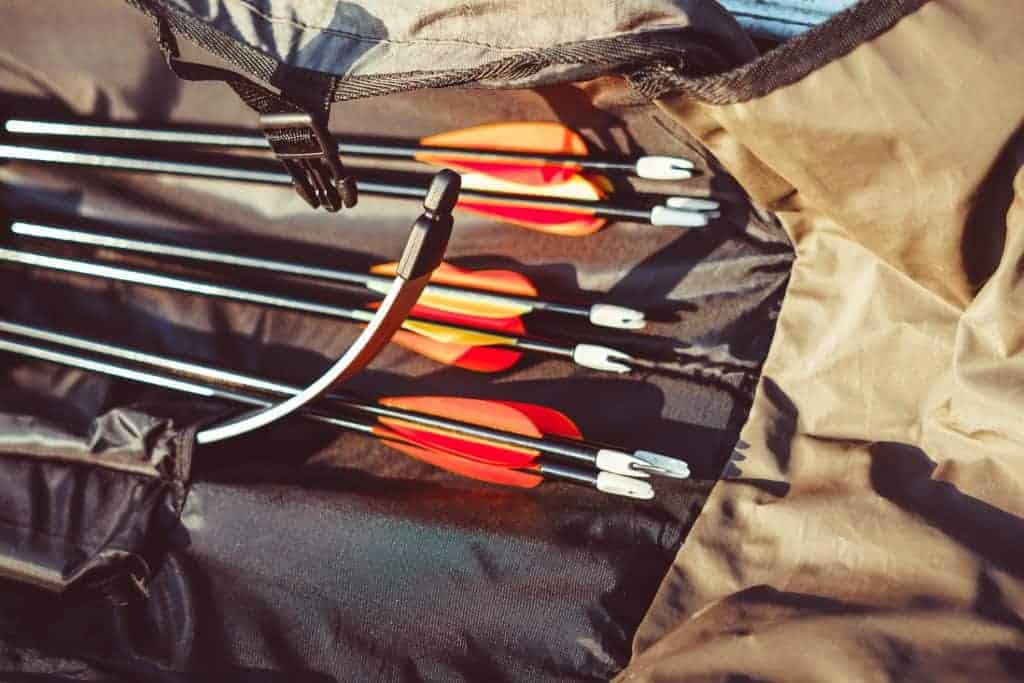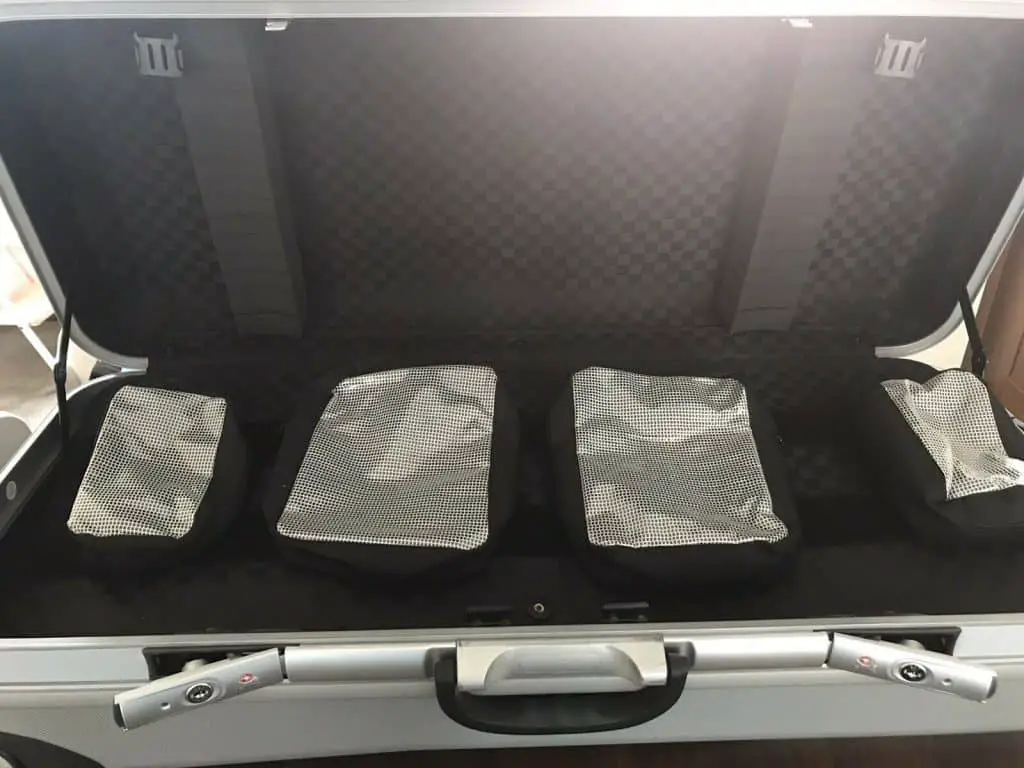Fact checked by Steven Lines, lifelong Hunter and Outdoorsman .
.
You’ve spent a reasonable amount of time and money picking out the bow you like, and even more, getting it set up and accessorizing it. You are going to want to protect that money and energy spent on your finely tuned bow. One of the most crucial but often overlooked pieces of gear for any archer is a bow case.
Whether you’re taking your bow deep into the bush for hunting or on a short car ride to the range, there are plenty of hazards along the way. From drops on cement to bumps on car doors or more treacherous treks through wild country, your bow can receive damage from many sources no matter your type of bow use.
Cases protect your bow and accessories during transport, which is essential to keep everything functioning correctly.
If you have already looked at cases, you know there are plenty of options out there, and you may be wondering, are hard or soft archery cases better?
You can buy hard or soft cases at varying price points to fit your budget, and which option you choose is determined mainly by your bow type and how you use it.
Soft-shelled cases are great options for short trips when the bow remains in your possession. They can be purchased to fit most bow types. Cases with hard shells are better for longer trips, especially when going on a plane or another form of transportation where you have to hand the bow over to someone else. Hard varieties are also better for journeys into the rugged bush; their sturdier construction will offer far more protection for your gear.
Don’t let your bow to become damaged due to neglect during transportation. Cases can be found to fit any budget and will save you money in the long run. Take a closer look at the considerations you need to know when purchasing a case by reading our primer on hard and soft archery cases below. Spoiler: there is a third option that attempts to blend the best of both worlds.
In this post, we'll cover:
Five Considerations Before Purchasing a Case
Before you begin looking at case styles, you will want to answer the questions below. That way, when you are looking at the available products, you can significantly narrow down your search to help you find the case that is best suited to you and your bow.
Make a note of the answers you have to each question so you can use them in your search or give them to a pro at your local archery shop.
Answer these questions:
What Style of Bow do you Have?
The obvious first question is to note the style of bow you have, as almost every case is designed with a specific bow type in mind. You want to be very explicit about the kind of bow. Is it a hunting or target compound bow; a takedown or single-piece, traditional recurve; or a longbow.
Each of these bows has cases that are specifically designed for that bow type. For example, a target compound bow won’t fit into every compound bow case. You don’t want to purchase one and then take it home only to find out that your bow type does not suit. Save yourself time and frustration by noting the exact style of bow you have.
How Will You Use the Case?
If it is strictly for transportation, know what type of transport you will use, car, truck, or air. If your bow is going in the back of a truck on the way to your favorite hunting spot, hiking location or, 3D course, your needs will be different from someone who will be taking their bow to the range on cushy car seats.
If you also plan to use your case as a form of storage at home, consider where it will be stored. If it is going in a closet next to other items or will be in peril due to playing children, energetic pets, or large tools, then you will need a sturdier case.
Will You be Flying with Your Bow?
When you fly with your bow, you will have to hand it over to airport security and baggage handlers who handle thousands of pieces of luggage in a day and will not treat it as gingerly as you might.
Look for cases that sport the label “airline grade” or similar. These cases will be sturdier and usually offer to lock mechanisms to keep your bow safe from the many hazards of air travel.
You can still use them to go hunting or to the range, and they make great options for storing your bow as they offer maximum protection from hits and falls.
How Much Equipment Do You Have?
If you want to be able to grab the case and head out to shoot, then you will want to look for options that can hold all of your gear.
Some cases are made to hold just the bow and nothing else. Other options have a multitude of straps, compartments, and pouches to keep and protect all of your gear, including arrows.
For takedown recurve bows, you can even purchase backpack style bags that have great ergonomic designs. These backpack models can make it easier to carry your bow longer distances.
What is Your Budget for a Case?
Both hard and soft cases are available at affordable price points, so you want to know what you can spend before you even begin looking. If you need maximum stability to protect your bow and all of your gear during air travel with TSA-approved locks, then you might be looking at the higher end options starting at around $100 and going up from there, but for a simple case, you can find both hard and soft styles for as low as $20-30.
Hard, Soft, or Hybrid

There are actually three main styles to be aware of when choosing a case. Soft varieties offer less protection but more modularity. In contrast, hard cases provide increased stability with a decrease in modularity. Hybrid models try to strike a balance between the two by making comprises in both categories.
You want to think about everything that you will need to keep in your case, the protection it offers, and the durability of the material it is made of it.
Let’s dive into the specifics of each case type, what you want to look for, and the pros and cons of each option.
Hard Cases
Starting at the highest level of protection and durability are hard cases. These models come in several sizes and configurations to fit almost any style of bow.
While these cases are bulkier and more cumbersome, they will grant you peace of mind when you put your case containing your bow, and perhaps your sights, rests, and other gear in the back of a truck or hand it over to an airline. This added security is worth the extra bulk and weight if you take your bow cross-country for hunting or competition. Whether you travel by air or vehicle, long trips offer ample opportunity to damage your bow. Thus, you are going to want a hard case for longer trips.
What to look for:
- Find a case that offers some wiggle room for your bow, but not a lot. If the fit is too tight and the case is dented, this can cause damage to your bow inside. Having a bit of extra room provides the space for deformation in the case without harming your bow.
- Thick materials that will provide greater security than thin-walled plastic, which can be dented with less force than thicker-walled plastic and other materials.
- Customizable padding inside the case using pull-and-pluck foam will give you more options to configure the case for your bow and accessories. This is especially important if you are just starting and may add or swap out the gear as soon as you become a more proficient archer.
- A separate compartment for a quiver or slots for arrows will protect their vanes and feathers while you transport them.
- TSA-approved locking latches are necessary if you plan to take your bow on a plane.
A thick-walled, well-constructed hard case offers excellent shock absorption and is made from durable materials that can protect your bow while lasting years, especially if you go for a model with customizable foam inserts.
A hard case is your best option for air travel and road trips. They are also a great option if you plan to use it as a storage option at home as well.
Soft Cases
Usually, the least expensive option, soft cases are more budget-friendly, but at the cost of security and peace of mind. These are the most basic of all cases. They are lightweight, which makes them easy to transport. The options here almost limitless as every manufacturer has several soft case options to fit most bow styles.
These softer styles range from thin fabric and leather models that offer almost no shock protection and some abrasion resistance to options that have a bit more structure to them with foam inserts to provide more shock absorption.
Some of them have a single compartment that will hold your bow and not much else. Other models offer straps, pouches, or compartments that can fit your other accessories.
Consider all the equipment you have to take with you when heading out to shoot. Do you have rangefinders, extra arrows, Allen wrenches, string wax, broadheads, field tips, nocks, releases, extra batteries, a wind checker, gloves, arrow pullers, or scorecards? Having everything in once place makes it easy to grab-and-go without forgetting anything. Having a place for everything also means you can find your gear much more quickly.
The downside is that you can’t put these cases in the back of a truck or anywhere that it might be knocked or bumped around. They work well if you are putting it in an empty trunk or the inside cabin of a vehicle while you make a quick trip to the range.
What to look for:
- An outer shell made of abrasion- and tear-resistant, durable material will keep your case from prematurely wearing out. Cordura or something similar is a long-lasting option that will mean you need to replace your case less often.
- You want padding that is thick enough to provide some shock protection if you drop your bow or bump it into a car door etc. Accidents happen, and selecting an option with no padding means no security from any kind of drop or hit your bow might take.
- Get a case with separate compartments for quivers or arrows. Soft cases without specialized compartments for arrows can put pressure on the shaft when the material of the case flexes and bends, leading to twisted vanes and feathers, which can affect arrow flight or render them useless.
- Find one with storage for all of your gear. Having a place for everything in your case means you can pick it up and head out the range without having to go and collect the rest of your gear, and it will also prevent you from forgetting vital equipment.
Some soft cases are more for dust protection and offer little shock absorption. These are not a great choice, as mistakes will always happen. Consider getting a soft case that offers at least some protection from falls and hits with foam inserts.
You want to be aware of the case material as hard-wearing materials will last longer requiring you to replace it less often, saving you money over time.
This option is only really suited to those who can transport their bow in the inside cabin of a vehicle and are taking it a short distance to the range. For any other bow use, you will want something that offers more security for your bow and accessories.
Hybrid Cases
Hybrid varieties are usually made from similar materials to soft cases but offer reinforcement in essential areas to provide more defense from damage for your bow and gear. They aren’t as rugged as hard cases but offer more modularity. They try to strike a balance between weight, size, and protection.
By trying to blend the rigidity of a hard case with the modularity and storage options of soft cases, hybrid cases can’t do any of these as well as the respective counterparts. They are a jack of all trades but master of none.
What to look for:
- An outer shell made of abrasion- and tear-resistant, durable material will keep your case from prematurely wearing out. Hybrid cases are made out of the same stuff as soft cases, so you have the same consideration here.
- Reinforcement at crucial stress points will provide similar protection to hard cases. Hybrid cases have a rigid structure in the corners, giving the case increase stability over their soft counterparts.
Hybrids are all about versatility. At the top end, you will spend more, but you can also get a case that will suit any type of transportation from a quick trip to the range to road trips and even airline travel. At the lower end of the spectrum, you will pay less, but in return, you only get slightly improved protection over softer options, which means they will not hold up to air travel or more rugged treks.
With some careful consideration, you can find the perfect case for your needs from the thousands of options out there. If you opt for a sturdier choice, it can also serve as a mode of storage at home when you aren’t using your bow.
Conclusion

Your bow is a highly tuned piece of gear and requires adequate protection to keep it firing accurately. Do not neglect to select an appropriate case; you could end up having to spend more money fixing your bow or buying a new one.
Deciding whether hard or soft archery cases are better comes down to what bow you have, how you use it, how many accessories you have, and what kind of travel you take your bow on; hybrid options are also available, which can offer the best of both worlds.
For short trips to the range in a protected environment, like inside a vehicle, a soft or hybrid case could be just the ticket with their lighter weight making them easier to carry. However, for rougher journeys, you will need a heavy-duty option to provide the protection your bow deserves, go for a high-end hybrid or a hard case. If you plan on taking your gear on a plane, look for something that is designed for air travel and has TSA-approved locks.
Before you begin shopping, jot down your answer to our five considerations above and note what to look for in whatever case style you are looking to buy. Use these when searching online or when heading to a pro shop. If you are shopping online, you might want to stop by a shop anyways, that way you can have a look at each style of case and get a feel for how they function and the kind of security they provide.
Having the right case will provide peace of mind and keep your bow in good working condition for years to decades.
How To Store A Recurve Bow (Without Ruining It)

Steven Lines is a hunter and outdoorsman from Safford, Arizona, USA. Since he was a child, he has been hunting and fishing and has over 20 years of outdoor experience. Steven works as a hunting guide in Arizona during his spare time and runs a Youtube channel dedicated to sharing his outdoor adventures with others.
dedicated to sharing his outdoor adventures with others.
